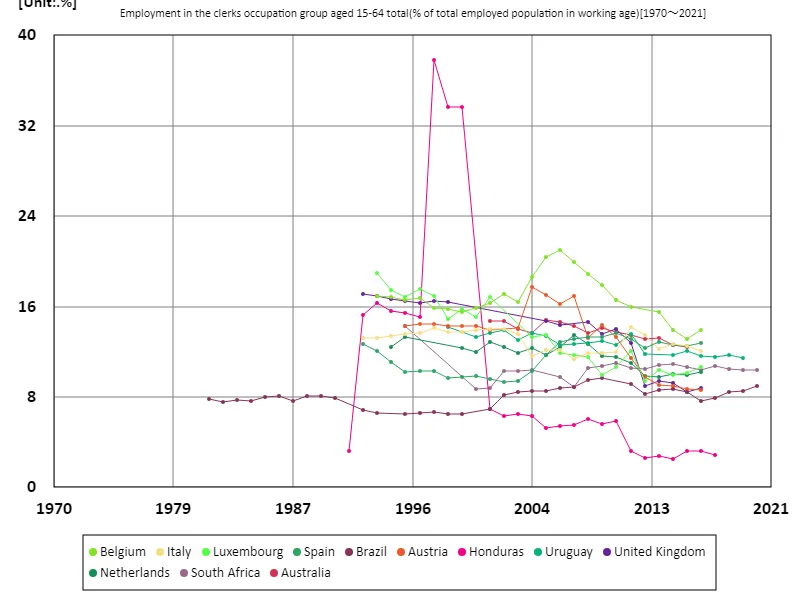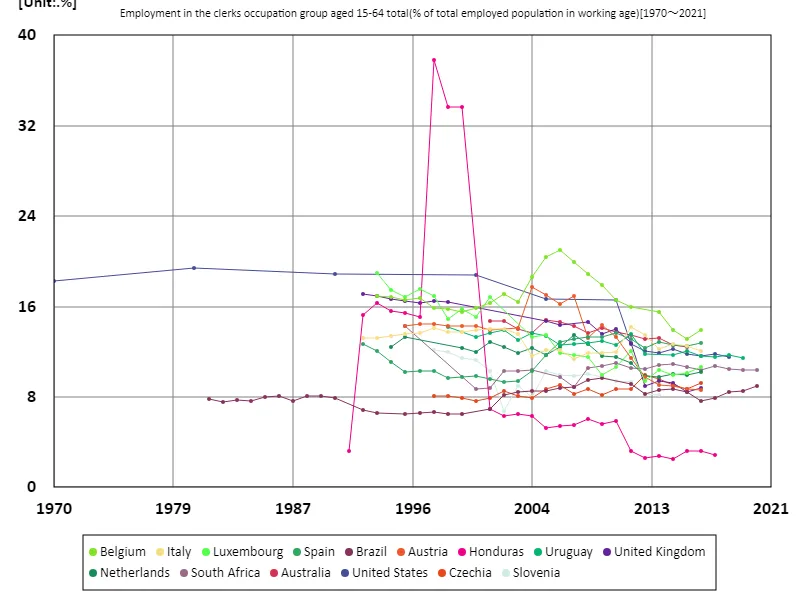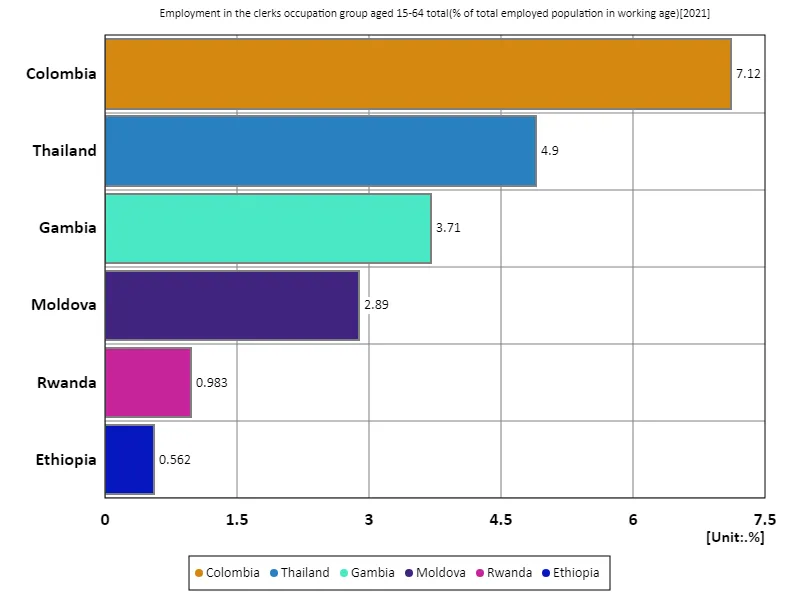- Abstract
- Employment rate for clerical workers for the entire 15-64 age group (ratio of working-age population)
- Employment rate of clerical workers for the 15-64 age group as a whole (percentage of working-age working population) (worldwide)
- Employment rate of clerical workers for all 15-64 year olds (ratio of working-age population) (worldwide, latest year)
- Reference
Abstract
The average age of male workers between 15 and 64 indicates the structure of the economy and the maturity of the labor market. In countries like Moldova, where the average age is high at 44, the ageing of the workforce is prominent. This could be indicative of a declining birth rate, an outflow of young people, and the effects of an ageing society. Generally speaking, countries with developing economies or those in transition tend to have older workers. Conversely, in developed countries where young people have a greater input into the labor market, the average age tends to remain relatively low. These data are important indicators for understanding each country’s economic situation, policies, and social background.
Employment rate for clerical workers for the entire 15-64 age group (ratio of working-age population)
Data from 1981 to 2020 show notable fluctuations in clerical employment rates for people aged 15-64. Honduras peaked at 37.9% in 1997 but has now fallen to 7.66%. These fluctuations are thought to be due to structural changes in the labor market, economic diversification, and industry shifts. While the most recent data shows that some countries, such as South Africa, have relatively high employment rates in clerical occupations, countries that previously had high employment rates in clerical occupations overall have tended to shift to other industries as their economies grow, resulting in a decline in the proportion of clerical occupations. Additionally, technological advances leading to the automation and outsourcing of work are also likely to be affecting the employment rate of administrative positions. Thus, the employment rate of administrative workers is not just a labor market indicator, but is deeply related to structural changes in the economy and technological innovation.


The maximum is 37.9%[1997] of Honduras, and the current value is about 7.66%
Employment rate of clerical workers for the 15-64 age group as a whole (percentage of working-age working population) (worldwide)
There is a clear shift in the employment rate of clerical workers aged 15-64 between 1970 and 2020. In particular, in 1997, Honduras recorded a high clerical employment rate of 37.9%, but today this rate has fallen significantly to 7.66%. This change reflects a shift in Honduras’ economic structure. At the peak in the past, clerical work was the predominant form of employment, but with economic growth and industrial diversification, the proportion of other occupations, such as manufacturing and services, is thought to have increased. Looking at data from other countries, even in countries where the employment rate of clerical workers was high, the proportion of clerical workers tends to decline as the economy develops. This is due to factors such as the automation of work, advances in IT technology, and outsourcing of work, and is one of the reasons for the decrease in clerical jobs. Furthermore, changes in the global economic environment and transformation in industrial structure are accelerating this trend. In other words, the employment rate of clerical workers is closely related to economic development and often fluctuates with industrial changes and technological innovations.


The maximum is 37.9%[1997] of Honduras, and the current value is about 7.66%
Employment rate of clerical workers for all 15-64 year olds (ratio of working-age population) (worldwide, latest year)
Based on 2021 data, Colombia has the highest clerical employment rate among all 15-64 year olds at 7.12%, compared to an average of 3.36% and a total of 20.2%. The data shows that clerical employment tends to be relatively low. Colombia’s high clerical employment rate suggests that the country’s labour market may be dependent on clerical work, whereas other countries tend to have relatively low proportions of clerical workers. This trend is linked to technological advances and the increasing outsourcing of work. This is because advances in digitalization and automation are changing the role of administrative staff and making some administrative tasks more efficient. In addition, the importance of administrative jobs has declined relatively amid rapid growth in other sectors such as manufacturing and services. Overall, although employment rates for administrative jobs vary by region and by stage of economic development, technological innovation and industry change are having a major impact on rates.


The maximum is 7.12% of Colombia, the average is 3.36%, and the total is 20.2%



Comments